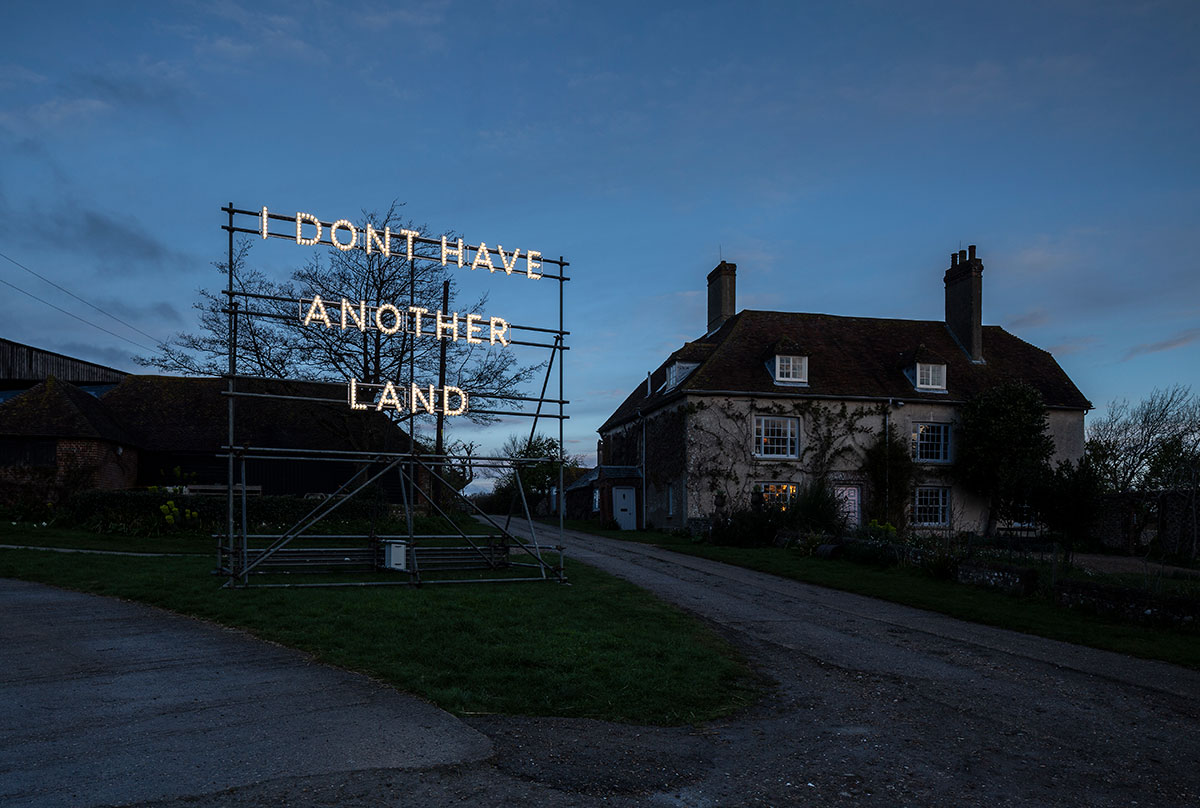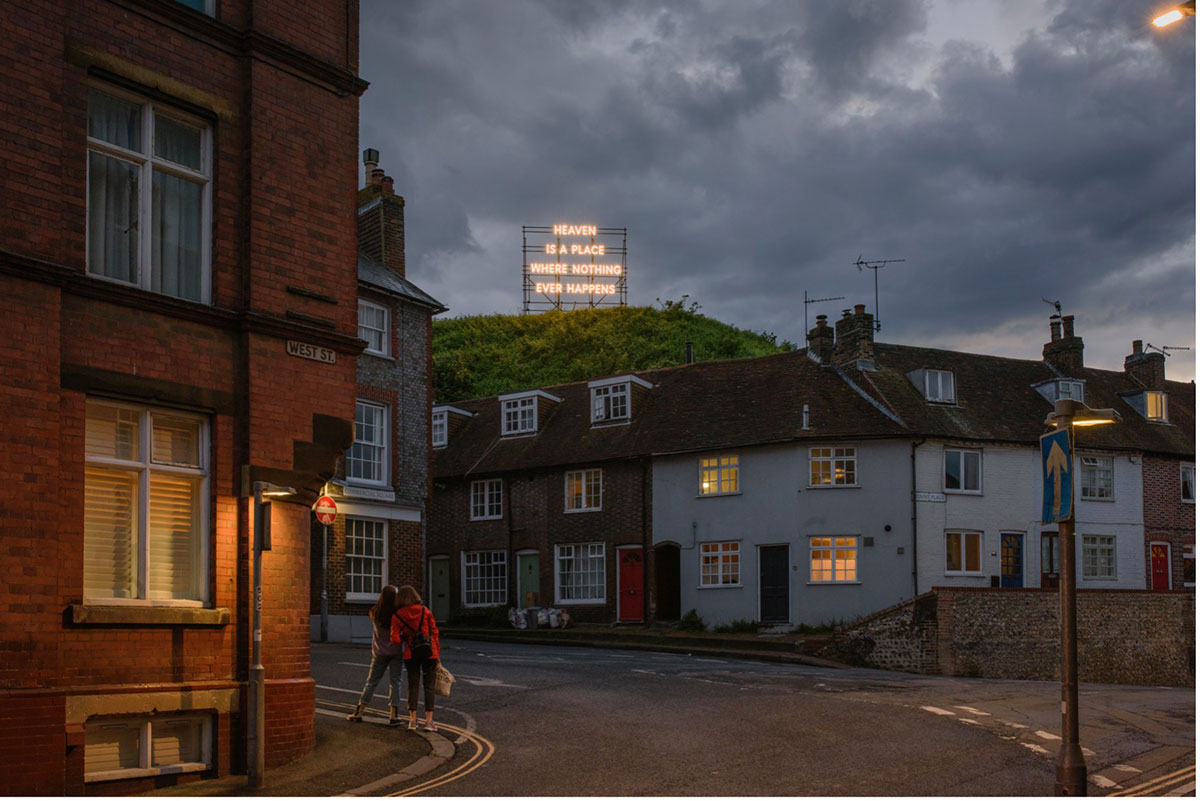PRESENTATION: Nathan Coley-Tentative Words Change Everything, Part II
 Nathan Coley creates work that questions how we relate to public spaces and architecture. His work is driven by research centring around the social aspects of our built environment and the communities and individuals who occupy it. As a graduate of Sculpture and Environmental Art, Coley was encouraged to explore ideas rather than a traditional artistic medium such as sculpture or painting (Part I).
Nathan Coley creates work that questions how we relate to public spaces and architecture. His work is driven by research centring around the social aspects of our built environment and the communities and individuals who occupy it. As a graduate of Sculpture and Environmental Art, Coley was encouraged to explore ideas rather than a traditional artistic medium such as sculpture or painting (Part I).
By Dimitris Lempesis
Photo: Sussex Modern Archive
Nathan Coley views himself as someone who makes objects, working across a wide range of media including sculpture, photography, and film. Often looking to recognisable pre-existing architecture, Coley is well known for his sculptural work which investigates the underlying political, social and ideological systems of communities. Whether creating sculpture, photography or film, the artist sees his work as a form of communication within itself. A series of large scale outdoor light sculptures by Turner Prize shortlisted artist Nathan Coley have been installed at six locations across Sussex as part of a new outdoor exhibition featuring some of the artist’s most important works sited in spectacular locations across the region. The exhibition “Tentative Words Change Everything”, is part of Sussex Modern, a pioneering partnership bringing together some of the region’s leading cultural organisations and vineyards in the distinctive landscape of the South Downs National Park. A major new commission by the artist has been unveiled at Charleston, the former home of artists Vanessa Bell and Duncan Grant. The new work encourages audiences to think differently about the history and contemporary relevance of the rural home of the Bloomsbury group.
Exhibition Locations:
St Mary’s Church, Glynde: “YOU CREATE WHAT YOU WILL” (2014). The name ‘Glynde’ comes from ‘Glind’: the old Saxon word for an enclosure. The Trevor family have owned the estate here for over 300 years. Dr Richard Trevor—who was Bishop of Durham between 1752 and 1771—demolished the medieval building and commissioned the architect of the Bishop’s Palace in County Durham to design a new church. It was built by John Morris, a builder from Lewes, in the style of Venetian architect Andrea Palladio.
Rathfinny Wine Estate, Alfriston: “A PLACE BEYOND BELIEF” (2012). A young woman tells a story of travelling on the New York subway some weeks after 9/11. A Sikh man, a Black woman with a baby and a train full of fearful commuters are involved in a confluence which stretches their collective sense of perception, trust and humanity. At that moment, the woman realises that for New York to get past the attack, to move on and rebuild itself, it has to think anew. It has to look again. It has to get to a place beyond belief. The Cuckmere Valley was drained in the Tudor times, and man-made ditches line the valley floor. Apart from a small number of sea defences beneath the coast guard cottages, the cliffs are being allowed to erode naturally. Rising global temperatures and sea levels will eventually cause flooding of the valley, creating a salt marsh.
Junction Road Car Park, Eastbourne: “WE MUST CULTIVATE OUR GARDEN” (2006). The 18th century satire “Candide” by Voltaire follows the journey of a disillusioned young man. The character meets kings and queens, a politician, a thinker and an artist on their travels before announcing in the final line: “we must cultivate our garden”, as if advising others to act practically and not optimistically when faced with similar disillusionment. In May 1849, the railway arrived in Eastbourne and transformed the town. The Junction Road signal box is Grade II listed, one of only two surviving Saxby and Farmer Type 5 signal boxes in the country. The Junction Road car park dates from the 1960s and is not listed. Between 1958 and 1964, a direct Glasgow to Eastbourne sleeper train operated.
Brack Mount, Lewes: “HEAVEN IS A PLACE WHERE NOTHING EVER HAPPENS” (2008). Heaven is a wooden roof or canopy over the outer stage of an Elizabethan theatre. In 1982, a prominent US Baptist claimed that Led Zeppelin’s ‘Stairway to Heaven’ contained satanic references leading to it being played as evidence at the Consumer Protection and Toxic Materials Committee of the California State Assembly. Heaven is newly ironed cotton sheets on a freshly-made bed. Heaven is a famous gay nightclub in Villiers Street, London. ‘Heaven’ is a song by Talking Heads. Lewes Castle was built as a Norman motte-and-bailey fort but, unusually, had two mottes. The area between Brack Mount and the motte on which the later castle was built is the interior courtyard, known as a bailey. It has been the site of a bowling green since 1640, but because the green is so uneven, the players use a jack with flat sides to stop it rolling.
West Beach Promenade, Newhaven: “YOU IMAGINE WHAT YOU DESIRE” (2014). The River Ouse used to flow into the sea at Seaford, two miles east. In 1539 a cutting was made for the river, and the new haven was formed. Newhaven has one of the few sandy beaches in East Sussex, but it has been closed to the public since 2008. Above West Beach is the Newhaven Fort designed by 22-year-old Lieutenant John Charles Ardagh of the Royal Engineers to protect Britain from Napoleon III. It takes four hours to reach Newhaven from Dieppe by boat.
Charleston, Firle: “I DONT HAVE ANOTHER LAND” (2022). In 1916, the writer David Garnett and his lover the painter Duncan Grant were conscientious objectors to WWI, and their relationship was criminalised. David wrote to his mother: “Vanessa has taken a house in Sussex and a farmer Mr. Hicks will employ Duncan and me and will teach me farming”. The “Vanessa” of his letter was the artist Vanessa Bell, and over the following six decades Charleston became the rural home of the Bloomsbury group, transformed into a modernist work of art by Grant and Bell.
Download the map of artworks here.
Photo: Nathan Coley, from the exhibition “Tentative Words Change Everything” Photo: Keith Hunter
Info: Sussex Modern, Sussex, United Kingdom, Duration: 14/6-29/8/2022, www.sussexmodern.org.uk/











